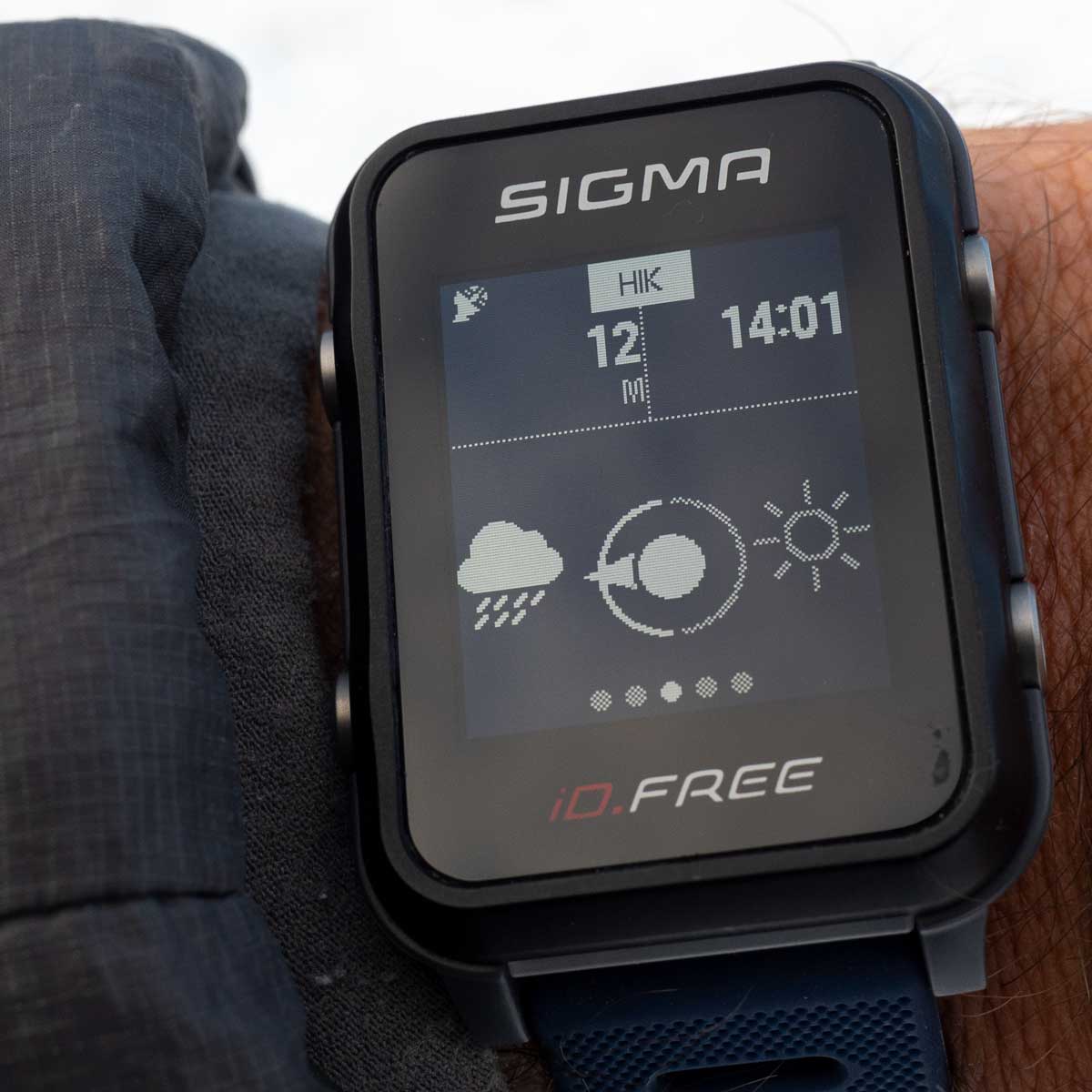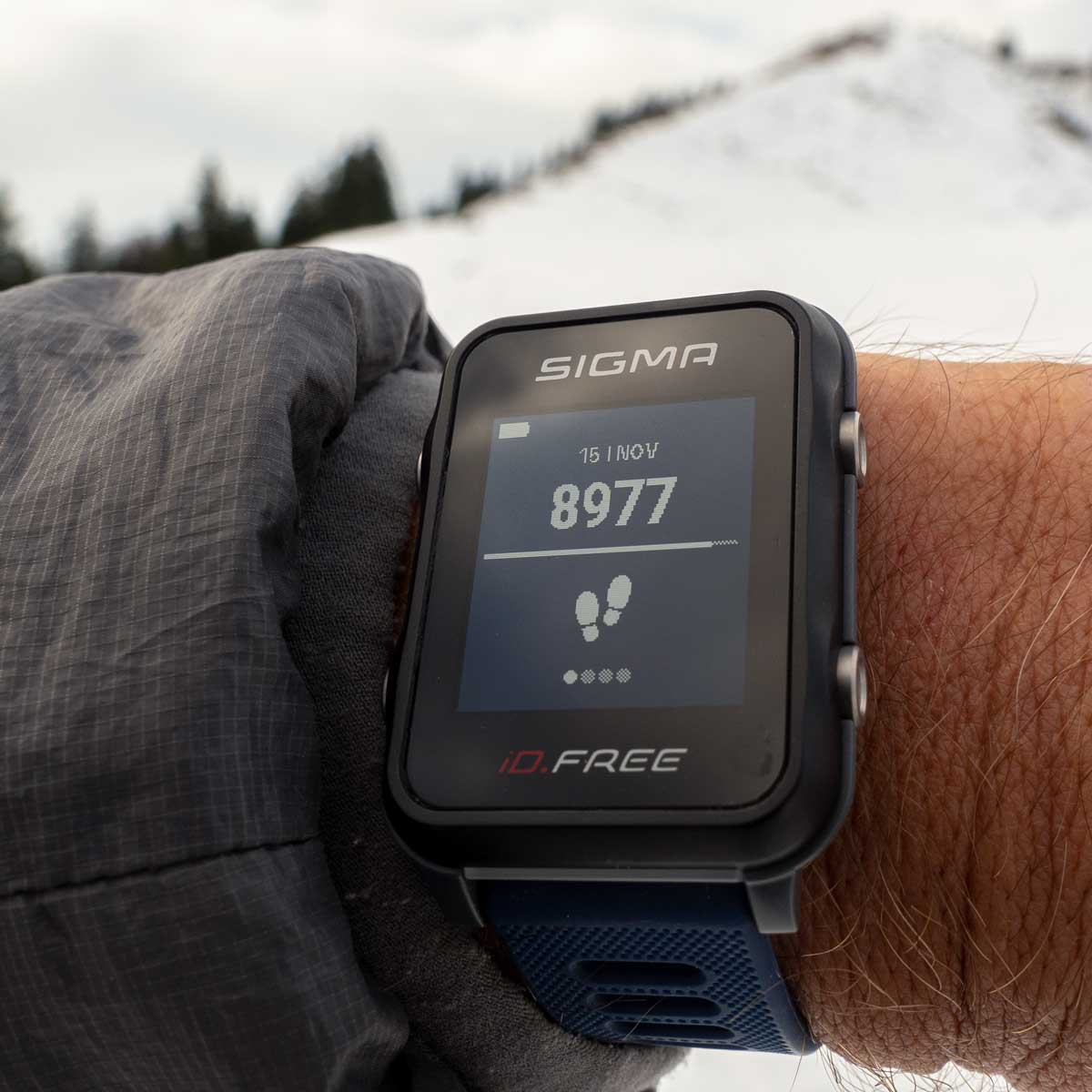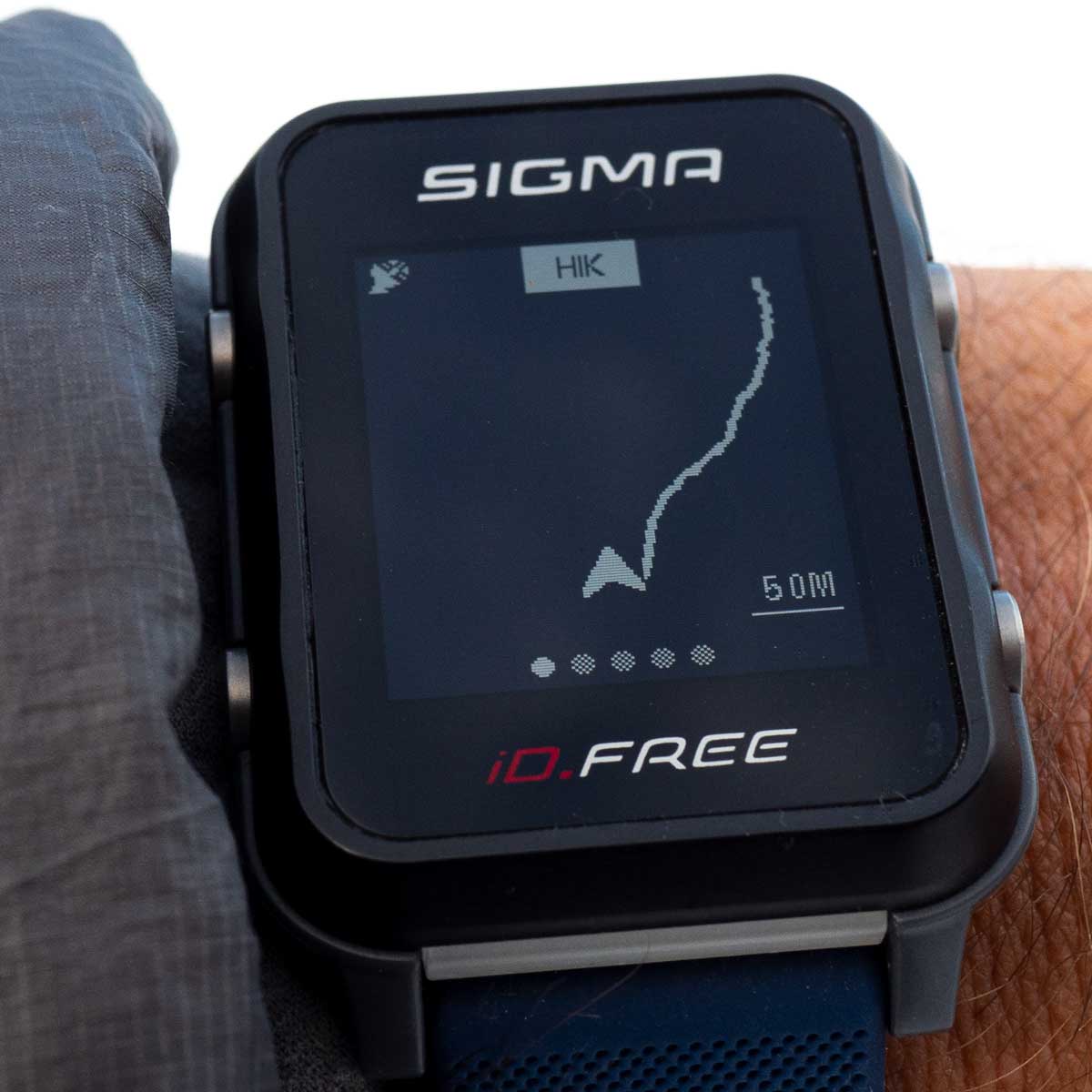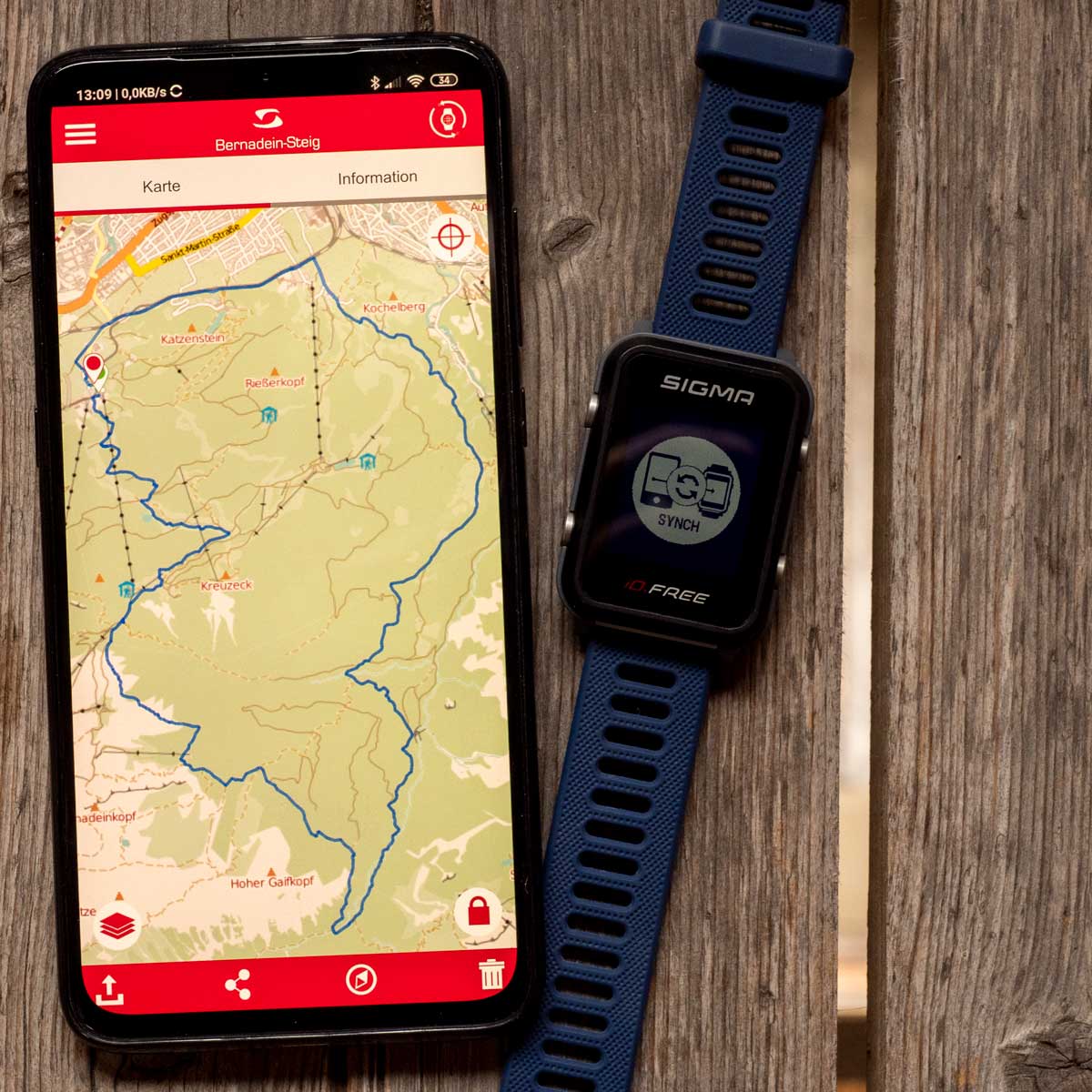Sigma iD.FREE review – the GPS multisport smartwatch from Sigma Sport reviewed!
Sigma Sport – especially known by bicycle computers like the ROX 12.0 Sport – also offers some wearables. These include the iD series with six different models – two of which are brand new: the iD.TRI for triathletes and the iD.FREE for outdoor enthusiasts.
We took a closer look at the iD.FREE, a multisport watch for running, cycling, swimming, skiing, hiking and geocaching. But that’s not all, the iD.FREE can also be used as an everyday watch and fitness tracker.

Sigma iD.FREE Review – Design, Technology
The iD.FREE is with 42 g and dimensions of about 4.7 x 3.6 x 1.2 cm quite light and small – especially when compared to the "king of outdoor smartwatches", the Garmin fenix 6X Pro. The iD.FREE is made of plastic, the four buttons are made of stainless steel, the display is protected by a mineral glass. The display glass is slightly set back to protect it from scratches. The 20 mm silicone wristbands – available in grey, green, blue and plum – are easily replaceable.
The water resistance is indicated by Sigma with 5 ATM. Swimming is possible, our review copy survived numerous shower events without any problems.
iD.Free’s appearance can be discussed: As an outdoor watch yes, as an everyday watch rather no. From our point of view, the iD.FREE has a functional design.
The visible area of the display is limited to a modest 2.4 x 2.1 cm. Unfortunately, Sigma Sport doesn’t give details about the resolution and the display type. The displayed data and labels are pin sharp, but sometimes much too small – eagle eyes are an advantage. The readability is good even under difficult lighting conditions, the non-adjustable backlight can be activated by simultaneously pressing the two buttons at the bottom left & right.
Smart Light – behind this is a "flashing light" integrated in the lower part of the housing that faces the body. When the iD.FREE is charged, it indicates the charge level ; in addition it provides information on turns, incoming smartphone notifications and target zones. Target zones include heart rate and speed (either pace, speed or min/100m). If the user is in the target zone, the display is green, blue below and red above. If the sun is strong, the light is not necessarily visible.
The Smart Light has one disadvantage: In the dark it can be disturbing – but the target zones can be deactivated in the Sigma Link App.
The iD.FREE features ANT+, Bluetooth Smart and USB for communication:
- ANT+: Connecting sensors*
- Bluetooth: Connect to smartphone or sensors*
- USB: For charging and connecting to a computer; the iD.FREE goes into mass storage mode, all folders and files are accessible (approx. 33 MB free memory)
*: heart rate, speed, cadence, combined cadence/speed, power meter
While reviewing we have used the iD.FREE temporarily with a Garmin HRM-RUN ANT+ heart rate chest strap or a Polar OH1 wrist strap; the setup and repeated connection works without problems. The same applies to the connection with a smartphone.
Bicycle sensors (speed & cadence) can only be used with the sports profile "Bicycle"; if you change to the profile "Other", the speed and cadence are not displayed. So if you want to use two different bicycles with different profiles, you can not use the sensors for one profile.
Sigma indicates the battery life as follows:
- Training with GPS (normal), heart rate, sensors: up to 8 hours
- Training with GPS (Eco), heart rate, sensors: up to 12 hours
- Fitness Tracker: up to 10 days
- Fitness Tracker with heart rate: up to four days
- Fitness Tracker from: up to 14 days
We checked the first case, with smartphone connection and activated heart rate sensor we came to pretty much 8 hours. By the way, according to Sigma FAQ, the integrated heart rate sensor doesn’t consume much power and isn’t important for battery life.
The integrated altimeter can be calibrated manually by entering the altitude; in addition, an altitude can be stored as the starting altitude (e.g. for the frequent starting point of a running workout). The built-in compass is calibrated by turning the iD.FREE.
iD.FREE Review – GPS
The GPS receiver only has GPS, there is no other GNSS like GLONASS or GALILEO. Sigma apparently uses A-GPS (Assisted-GPS) for a fast satellite reception; an indication is the file "HOST_EPO.DAT" in the internal memory. This file is updated via the Sigma Link App or the Sigma Data Center. However, it is not clear how long the data is valid, so regular synchronization with the apps is mandatory.
When starting a training – admittedly under rather difficult "GPS conditions" – it still happens that the iD.FREE cannot determine the position until the second or third attempt.
We judge the GPS accuracy by reviewing track recordings; in the sum the FREE leaves a good picture, deviations are mostly in the "usual" range of 5 to 10 meters.
However, what happens in the power-saving GPS Eco mode is not quite obvious. Track points are still set at 1s intervals, but the tracks are less accurate.
iD.FREE Review – Heart Rate
For all smartwatches reviewed so far we come to the following conclusion:
With warm outside temperatures, a tight installation of the watch a little further up the wrist, a load intensity that is as even as possible and even & rhythmic arm movements (e.g. when running), very good results can be achieved analogous to a heart rate chest strap. With cold hands, a slipping around of the watch (e.g. triggered by tight cuffs of clothing, even when the watch is tight!), changing loads and irregular movements of the arm (e.g. walking with ski poles) the results can be miserable! All transitions lie between these two experiences.
Other factors influencing heart rate measurements are the physical characteristics of the user and the sensor firmware.

Sigma iD.FREE Review – Operation, Menu, Configuration
The operation of the iD.FREE is glove-friendly via four buttons. The interaction with the hierarchically structured, clear menu is easy to learn. Tip: the menu can be further simplified by switching off the fitness tracker.
Configuration can be carried out on the watch itself or in the Sigma Link App or Data Center. In these two applications, the setup is not only more convenient than on the watch, there are also other options. This includes adapting the seven sports profiles:
- Bicycle
- Fitness
- Running
- Swimming
- Skis
- Other
- Hiking
Up to five data pages can be assigned to each profile, but only up to three data fields are possible on each page. This is not so good for runners, the four important types heart rate, pace, time and distance can not be displayed simultaneously. There is a large selection of possible data fields, a total of 76 types in 11 categories.
Swimmers can store any pool length, cyclists can define the wheel circumference (in mm).

Sigma iD.FREE – Functions
As an everyday watch, the iD.FREE can display smartphone notifications and offers an alarm clock, in addition there are three watch faces. As a fitness tracker, it records steps, calories, distance, heart rate and sleep.
We have tested the watch extensively in practice, especially when running and hiking. The iD.FREE serves its purpose, limitations like the small display and the mini font size have already been mentioned.
To navigate with tracks there is a kind of map display (figure above), it is necessary to follow the line of the track. The "map" does not allow zooming or panning, but there are practical messages like "Leave Track". In addition, helpful information such as direction and distance or the time to the destination can be displayed on a data page. Another useful function is to reverse a track, i.e. navigate in the opposite direction. There is also a function to get back to the starting point with the help of the current recording.
One possible data field is a weather trend (figure above). Further useful features are Auto-Pause and Auto-Round (manual or automatic according to distance or time), we did not try the Crash-Alert (in case of a crash the app informs after 30 seconds predefined emergency contacts via SMS).
Geocaching, the iD.FREE offers an interface to Geocaching.com. Included in the delivery is a voucher to try all premium features for 30 days. When registering with Geocaching.com, however, despite the voucher, the bank account must be deposited – after 30 days an automatic payment will presumably be made. That’s why we have decided against it. Alternatively, the coordinates of a cache can be entered via the keys, e.g. N 47° 54.191 E 011° 22.127. You navigate to the cache via a direction pointer; when the geocache is found it can be logged.
Other "games" are Activity Sprint, HR Slalom and Speed Recovery.
What is noticeable and annoying in practice is a delayed display of the data. If you change the data pages by pressing a button, it can take up to 3 seconds for the information to appear – for example the heart rate or altitude.
Sigma iD.FREE – Software
Sigma provides users two free applications: The computer software Sigma Data Center (for Mac and Windows) and the Sigma Link App (for Android and iOS). In addition, there is the Sigma Cloud, an online storage that can be used to keep data synchronized between the applications (requires a registration).
The two applications with their dedicated user interfaces are not a design highlight, but serve their purpose. They offer extensive functions for configuring the iD.FREE, all kinds of statistical data and the management and analysis of activities (records) and tracks. You could even do without the Data Center, but it offers an important feature that does not exist in the app: Importing GPX files with tracks.
A highlight is the integration of Komoot. Trips planned in Komoot can be imported into the Data Center or the Link App and transferred to the iD.FREE. Activities recorded with iD.FREE are uploaded to Komoot. In addition you can also connect Strava, TrainingPeaks and 2Peak, a tour download is also possible for GPSies, but this service will be discontinued soon.
If the interaction of Cloud, Data Center, App and iD.FREE is understood, the imported tracks can be brought to the iD.FREE or configuration changes can be transferred. At least in theory. For whatever reason, not every track is transferred, and patience is required when synchronizing. The synchronization between app and watch does not simply run in the background. During the sometimes tedious process a sync symbol appears, the iD.FREE can not be used with all functions. So it’s better to start the transmission at home while having breakfast and not at the starting point of an activity.
The following synchronization paths are possible:
- Data Center > USB > iD.FREE
- Data Center > Cloud (Internet) > Link App > Bluetooth > iD.FREE
- Link App > Bluetooth > iD.FREE
- Link App > Cloud (Internet) > Data Center

Sigma iD.FREE Test – Scope of delivery
In addition to the charging/sync USB cable, the sales package also contains a quick start guide, a good bike mount and two vouchers. One voucher for a Komoot map region and one for a 30 day Geocaching.com Premium membership.
Separate bike mounts can be purchased for the second or third bike.
Sigma iD.FREE Review – Summing Up
The Sigma iD.FREE offers a basic range of functions for everyday use, fitness, outdoor and training. There is no real enthusiasm for using the iD.FREE, but in view of the favorable street price you can overlook some shortcomings. The configuration via app is especially good, the small display with the sometimes too small fonts is less good.
In the price range of the iD.FREE, the Smartwatches from Huami Amazfit are to be seen first and foremost as competitive products. But these watches also have their weaknesses, and their range of functions is less suitable for outdoor tours.
Pros – Sigma iD.Free
- Price
- Functionality for several outdoor activities
- Komoot integration
- Cloud based synchronisation
- Comfortable configuration with the Link app
- Clear menu
- Bike mount in the box
Cons – Sigma iD.Free
- Small display & font size
- Not all tracks can be synchronised
- Documentation could be better
I bought this smarwatch 4 months ago. It sucks from all point of view, and the battery is now dead.
Hi, very interesting. Do I get you right, that the
Sigma free can be used with other chest straps? Are there any cheaper ones than the Sigma R2 Duo?
Tx, HPH
Hi,
yes, you can use other chest straps (via ANT+ or Bluetooth) – check e.g. amazon for alternatives to the R1 Duo chest strap